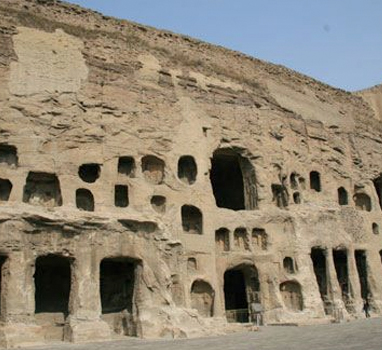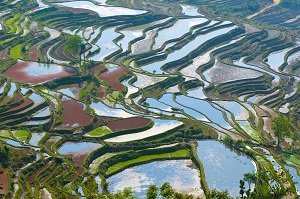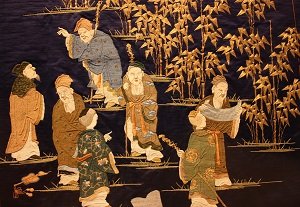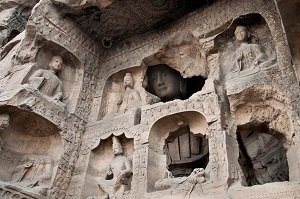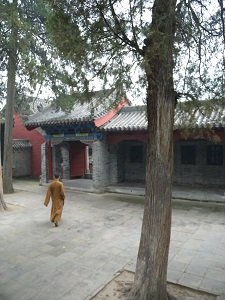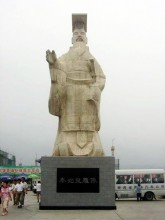Part III – The Age of Division: 220 CE – end of Sui Dynasty 618 CE
Introduction
The approximately 400 years between the Age of Division and the end of the Sui Dynasty, saw many familiar themes dominate. China endured fluctuating periods of fragmentation and reunification. Confucianism continued to permeate the fabric of Chinese society with its emphasis of filial piety and ancestor worship, and with a value system that allowed for the creation of a strong central government. The Northern Nomads were frequently problematic, and diplomatic and military solutions were constantly being considered. Agricultural productivity remained important not only to feed the population, but also to fill government tax coffers and to create enough surplus food to maintain the military. Sustaining a strong military was always a double-edged sword. Powerful generals in frontier regions often developed significant regional power which was then used as a springboard for a national campaign. The ability for China to stay unified ultimately became significantly effected by the creation of a national, homogeneous culture which taught universal values, such as loyalty, duty, compassion and morality.
New themes also emerged during this period: the introduction of Buddhism, land reform, the extensive colonization and population of Southern China, the beginning of the legal reform and the growing development of poetry. These challenges were often most successfully met when approaching these problems through a shared way of thinking. This shared way of thinking, or common culture, came to define what it meant to be Chinese. In other words, whether a nomad was considered Chinese was dependent not upon his racial origin or the territory into which he was born, but on how well he had assimilated into Chinese thinking, culture, language and customs. Chinese culture acted as a significant unifying force within Chinese society as it gave all regions of China the same principles around which to rally.
From a climatic point of view, tree ring data suggest that the Central Asian climate went through three periods of severe drought – in 360, 460 and 550 CE – each of which would have likely affected Chinese stability. When nomads in central Asia could no longer live off the land there, they migrated. Those migrating east and south would have increased instability in North China as they attacked weaknesses on the border and moved into northern farming lands in order to access the food and water needed to support their herds. From 400 to 570 CE, China suffered from an extended period of dry desertification, forcing farmers to migrate further south. The year 535/536 CE was particularly challenging. It is believed that a volcanic eruption or series of volcanic eruptions filled the atmosphere with ash and other debris, significantly diminishing sunlight and shepherding in a global volcanic winter. Chinese historical records suggest that temperatures were so cold that crops failed resulting in food shortages, famines, disease, population migration and unrest from which continued to affect China negatively for several decades thereafter.
The Age of Division 220-589 CE – Southern Migration, Daoism, Buddhism, Confucianism
The Han Dynasty began to disintegrate as the independence of wealthy families increased. Many refused to serve what they regarded as a corrupt imperial center. Eventually, the Han Dynasty fragmented and three rival states – the Sui, Wu, and Wei – took its place. This period is known in Chinese as Sanguo (Three Kingdoms) and their rivalry was immortalized in one of China’s greatest novels, The Romance of the Three Kingdoms. Yet, try as they did, none of these warlord families was able to conquer all of China. In particular, the north was shattered by continuous fighting between shifting nomadic and northern Chinese groups. Many nomads intermarried and integrated into Chinese society, while Han Chinese began to adopt certain nomadic customs and foods.
Constant fighting in the north caused 2 million people to flee south, abandoning the land of the northern frontier. Many resettled in the Yangtze River valley. This migration transformed the Yangtze valley and southern China into one of the most densely populated and prosperous regions of the country. Much of the south’s prosperity was driven by silk production, the trade of which continued to thrive during the Age of Division. The Yangtze River valley’s climate proved ideal for growing the mulberry bushes on which silkworm feed, as well as for the cultivation of tea and rice. Tea brought many health benefits to the population, not least because of its boiled water which killed water-borne germs. Similarly, rice proved to be an ideal food crop. It tasted good, was highly digestible and when consumed with soy products, offered excellent nutrition. When milled, it stored well. It was easy and cheap to cook, the only cereal that can simply be boiled without becoming mush. But perhaps most significantly, rice almost always yielded more calories per unit of land than other crops, important in a country with limited arable land. In good climates, two or even three crops could be grown in the same field.
Despite the disruption of the Age of Division, scholars and artists flourished, with notable achievements in areas such as astronomy, mathematics, pottery, philosophy and literature. Incidents from history, for instance, presented themes of courage and loyalty that lent themselves to the creation of epic romance and fantasies which were then transformed into plays and operas. Poetry also emerged as an important cultural phenomenon, a role it would continue to play throughout the spread of Chinese History.
Daoism (sometimes referred to as Taoism) also became more popular during this time. A belief began to develop that the three spheres – Heaven, Earth and Man – were interconnected by way of a primal substance, called qi (or chi) which made up all things, and that all things within the universe had developed in accordance with the patterns of nature which were the quintessential expressions of The Dao or The Way. If human beings worked harmoniously with these natural cycles, they were most likely to maximize the potential for various forms of well-being such as health, good fortune and fertility. For example, The Dao asserted that state executions should be conducted during the killing seasons of autumn and winter when nature brings an end to the life of plants.
In the face of constant warfare, Chinese again began to extensively debate the correct behavior of man in relationship to family and state. An environment of alienation and personal extravagance pervaded elite circles where Confucian ideals lost much of their hold. Many eschewed court life with its vicious cliques. A search for unaffectedness and spontaneity led to an outpouring of self-expression, especially in poetry. Chinese, with its tones and its plentiful rhymes, is well-suited to verse. The Chinese script, especially Classical Chinese, is equally advantageous to poetry writing because it creates visual associations in ways that purely phonetic scripts do not. Poetry became China’s most important literary form. From the Han time onward there was a strong link between poetry and emotion. Similarly, especially by Tang times, calligraphy came to be recognized as a fine art. The force, balance and movement of the character strokes were believed to indicate the calligrapher’s moral and psychological makeup as well as his momentary emotions. Calligraphy came to be considered so indicative of character that, in Tang times, it was used as a criterion for assigning posts in the civil service.

Among the most gifted poets, writers and musicians of the third century was a group of poets later immortalized as the Seven Sages of the Bamboo Grove. The Seven Sages argued that previous unquestioning compliance to Confucianism was, in part, to blame for the fall of the Han Dynasty. Daoist in philosophy, the Seven Sages discussed philosophy and art under a bamboo grove to escape the corruption and oppression of the court.
Buddhism, arriving in China from India during this time, gained quick acceptance in many parts of the country. Intellectually, Buddhism felt harmonious with many Daoist ideas, which was understandable since Daoist terms were employed by early translators to express Buddhist ideas. Buddhism also provided a new focus during a time when it was difficult to have much faith in civil government. It spoke to questions of suffering and death with a frankness that did not exist in native Chinese traditions, advancing a fully expounded vision of the afterlife and of the prospect of salvation. To many, its morality, including the sanction against the taking of life seemed to follow compassion to its logical end. That Buddhist monasteries became exempt from taxation was more controversial; as was monks’ vows of celibacy, since these vows contradicted the filial obligation to provide parents with grandchildren. On the latter point, Buddhists argued that it was the ultimate expression of filial piety to free parents from suffering by performing pious acts in their name. Buddhists believed that this would help ensure that those so honored would be born into a better life in their next reincarnation.
In a practical sense, particularly in the south, Buddhist monasteries provided food to poor peasants, built inns for travelers and developed rudimentary lending houses where poor people could leave items of value in exchange for loans for seeds and other needs. The coming of Buddhism also led to an increase in fiction writing as Buddhist teachers discovered that stories made effective teaching tools. In north China, the nomadic tribes competing for control of the Yellow River Valley embraced Buddhism because it gave them a civilized religion of their own. The Northern Wei emperors, from 425-494, funded the carving of thousands of Buddhist statues in cliffs and caves at a place called Yungang, which is now a UNESCO site and can still be visited today. Buddhism also brought to China new ideas about medicine and architecture. The Age of Division also saw much writing on the subject of botany as well as inventions as diverse as tofu, the wheelbarrow and the repeating crossbow.
Sui Dynasty 581-618
In 486 the Northern Wei began to institute reforms which significantly increased the effectiveness, and economic power of its state. The most important of these reforms was the creation of the “equal field system” in which the state owned the land, but gave most families lifetime-control over 40 mu (approximately 6.6 acres), ensuring that as much land as possible was occupied by taxpaying farmers. The equal field system helped diminish the power of local Chinese land holders. It increased the government’s tax revenue and raised agricultural productivity. Another important reform was the creation of a divisional militia, i.e. volunteer farmer-soldiers who served in rotation in armies at the capital or on the frontiers. Kitting out soldiers had become expensive because cavalrymen needed both armor to protect both men and horses from powerful crossbows. The cost of this army was minimized by allowing soldiers to farm when not called upon for training or for campaigns.
In 581 CE, Sui Wendi, born Yang Jian, gained control of what is now called Sichuan and the northeast of China in 577 CE. With an army of 500,000 men, and using a combination of naval and land attacks, Sui Wendi eventually conquered the South in 589 CE, reunifying China under the Sui Dynasty. Creating a unified dynasty was difficult because during the Age of Division, the north and south of China had developed in different cultural ways.
Both north and south had conserved Confucian tradition as the basis for their societies. In the north, however, the preservation of Confucian learning took the form of family ethics and rituals. Government service opportunities remained varied and strong, and such service offered standing, power, and contact to elite families from other parts of the country. Many northern elites spent large portions of their careers in the provinces, as they rose from junior posting to commanded forces. Often educated, the real-world experience of these high-ranking Chinese elites made them a real advantage for the northern rulers working to create strong states.
With government salaries guaranteed, and with no northern border which needed defending from militarily skilled, nomadic tribesmen, the South focused their Confucianism on developing the arts. Witty conversation, alcohol and poetry were commonplace in the southern court, as was analyses of the essential features of literary, artistic and philosophical works. Calligraphy and painting developed with the increased interest in individual expression. A Daoist interest in mountains as places of nature and as a mythological home for immortals led to the beginning of landscape painting. Xie He, an early sixth century painter, helped to articulate the qualities on which subsequent landscape painting would be judged. These attributes included the quality of being imbued with vital force and the strength, harmony and adeptness of the brushstroke. The articulation and the nature of these attributes imbued painting and calligraphy with an intellectual content that was not present in the decorative arts of ceramics, lacquer ware or textiles.
Northerners viewed southern artistic sensibilities as effete, while southerners viewed themselves as the true protectors of Chinese civilization and regarded many of the nomadic-influenced customs of the north to be uncouth and barbaric. This was particularly true of the more forward manner of women in their society. The north justified its claims to the status of Son of Heaven and successor to the Han Dynasty by emphasizing its geography. It controlled the region of historic imperial capitals, the land where all the places sacred and memorable in Chinese history were located. The northern court assiduously preserved the ritual tradition of the Zhou and the Han. The southern court could not claim geographical centrality. Instead, it pointed to the indisputably Chinese lineage of its rulers and elaborated a succession theory where the Han imperial seal passed to the Wei, to the Jin, and then to the Southern Song as the legitimate Sons of Heaven.
Yet, when China re-unified in 589 CE, the two different strands of its development were able to cross-fertilize each other. Yang Jian took the title of Wendi, “the cultured Emperor”, to show to the empire that he understood the importance for China of cultural as well as territorial integration. Wendi employed capable officials who justified his efforts in Confucian, Buddhist and Daoist terms. Engaging men who held deep Confucian values of loyalty to the ruler and duty to the people helped concentrate imperial power. To identify Confucians, the Sui reintroduced written examinations, testing knowledge of Confucian classics. The examinations also helped to standardize thought and to diminish the differences between the north-western, north-eastern and southern elites.
Under the Sui dynastic reign, the equal field system was introduced throughout the empire. By establishing uniform and low taxes on grain, cloth and labor services, the Sui were able to double the number of registered households for tax purposes within a few years of taking power. The Sui dynasty also introduced The Kaihuang Code, which attempted to bring order and leniency to the legal systems of the previous ages. It supported all of China’s major religions, particularly Buddhism. Court control over provincial administration was a critical issue to the newly formed court. To consolidate its control, the Sui reduced the number of prefectures and counties, and forbade officials from serving in their home prefecture or serving more than one tour in any county. These policies were designed to curtail the power of locally entrenched families and to keep scholar-officials from allying with them.
Millions of laborers were conscripted to rebuild the Great Wall and lengthen the Grand Canal between Hangzhou and Beijing. The Grand Canal eventually reached 1200 miles in length, 40 paces in width, and of sufficient depth to accommodate boats carrying 800 tons. The Grand Canal facilitated the flow of taxes paid in grain from the south to the imperial capital in the north. This Sui northern capital was situated in situated in Chang’an, close to modern day Xian.
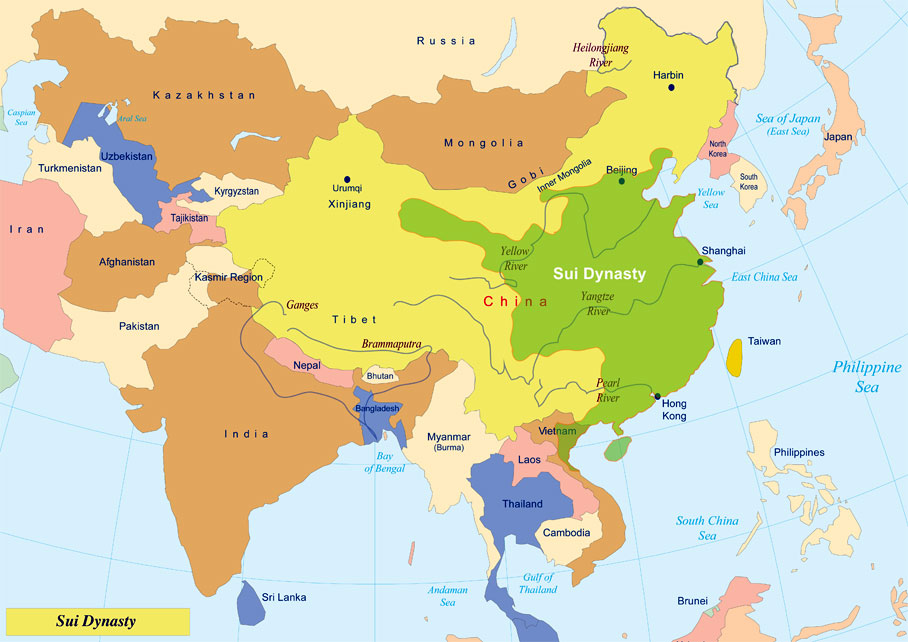
Chinese Culturalism and Historical Themes in Today’s China
By the end of the Sui Dynasty, China had undergone periods of fragmentation and reunification, yet this instability increasingly did not threaten the overall cultural cohesiveness of the Chinese nation. The foundation of this cultural cohesiveness was Confucianism. Buddhism and Daoism also influenced Chinese thinking, as did the militaristic values of the Legalist thinkers. These values, which formed the cultural heritage of Chinese civilization, were shared through government examinations (although these were intermittently discontinued). Instituting empire-wide exams meant that the ruling elite all learned from the same body of work whose knowledge then trickled down to the general population. These cultural traditions were reinforced through the continued collection and sharing of historical writings and the literature of China’s past. They were also bolstered through the development of new art forms such as Chinese opera.
This cultural tradition underpinned the Chinese people’s self-understanding and shaped its foreign policy until its increasingly difficult encounters with the Western world during the 1800s. The Chinese distinguished themselves from non-Chinese in large part by their adoption of the norms, values and customs of their cultural tradition, as opposed to defining themselves strictly by race or by being a people originating from any specific geographical territory.
Another dynastic theme seen in China today is the resurgence of Buddhism after its decades of suppression under the Communists. The return of Buddhism is most visible in the Jiangsu and Zhejiang provinces and in the large cities. Tibetan areas of China remain overwhelmingly Buddhist, particularly among the native population. Many previously destroyed monasteries throughout China are being rebuilt, a notable example being the Shaolin monastery, although some of this reconstruction is also motivated by tourism. Although accurate numbers are still difficult to come by, it is estimated that there were approximately 244 million Buddhist in China 2012. There is also an increase in the publication of Buddhist literature of all kinds, both by the monasteries themselves and by independent presses.
Land reform has certainly been a persistent theme in China’s modern history. The 1950s Communist redistribution of land from wealthy landholders to peasant farmers was remarkably like the Equal Field System that was first introduced during the Sui dynasty. China’s further redistribution of land after the failure of the collectivized commune system reflected the recognition that agricultural productivity was highest when peasants were farming for themselves as opposed farming for wealthy landholders or for the Communist state. Today, land distribution issues are often controversial as China’s massive infrastructure projects have forced million people from their homes, often without adequate compensation.
The migration of Chinese into the south of the country began a development that would eventually turn the southeast region of China, especially from the Tang and Song Dynasties onward, into one of China’s strongest economic regions. It remains so today. Guangdong province, for instance, in China’s southeast, is currently the most populous province in China and, since 1989, its GDP has been the highest of all provincial regions. In 2019, Guangdong GDP exceeded 9 trillion yuan or $1.3 trillion dollars which was approximately the size of Australia’s entire GDP.
What Happened Next?
The end of the Sui allowed for the establishment of the Tang Dynasty, considered by many Chinese to be the height of their civilization. After three centuries of cultural development that included the revival of Confucianism, the Tang was replaced by the Song, a relatively weak dynasty that succumbed to foreign invasion.

